This example uses the input of a PC.xls file. Using PK Submit, a full set of CDISC domains in SDTM 3.2 format will be generated and an NCA project will be created and set up to use the domains. At the end of the example, you will have a complete set of files for the study that are ready for electronic submission.
The major steps in this example include:
Create the PC domain
Create the PP domain
Create RELREC domain
Create files required for submission
Export submission files
Specify the dataset for the PC domain
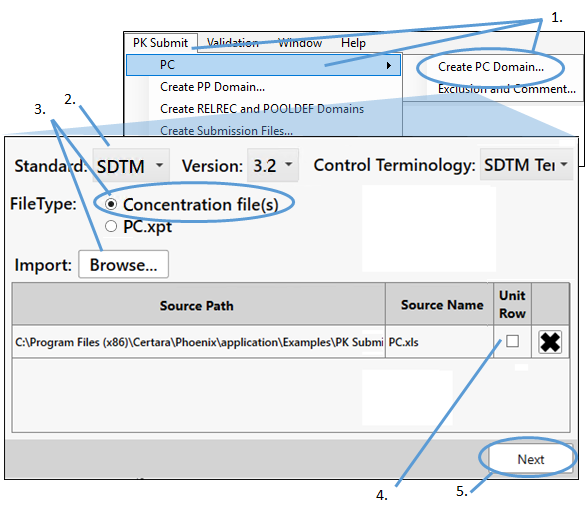
-
Select PK Submit > PC > Create PC Domain from the Phoenix menu.
-
In the PK Submit dialog, set the Standard and Version menus are set to SDTM and 3.2, respectively.
-
With the FileType set to Concentration file(s), click Browse, navigate to <Phoenix_install_dir>\application\Examples\PK Submit\Supporting files\Example2, select PC.xls, then click Open.
-
Check the Unit Row box to combine the first (column names) and second (units) rows of the Excel file.
-
Click Next.
Map the variables
The next step in the process involves lining up the variables in the input dataset with those in the PC domain. The variables are marked as either being required for the PC domain creation or optional. Many of the variables in the example PC.xls file are recognized by PK Submit as PC variables and, therefore, they are automatically mapped. There is one, however, that we need to manually map: PCRFTDTC.
-
Scroll down and locate PCRFTDTC in the PC.xls column
-
Click the left arrow in the PCRFTDTC cell.
This moves the row up to the end of the mapped variables. -
Scroll up to locate moved PCRFTDTC cell.
The PCRFTDTC data is now mapped to a column named PCRFTDTC2. -
Click Next.
-
Click Yes when asked about concatenating the study ID and USUBJID.
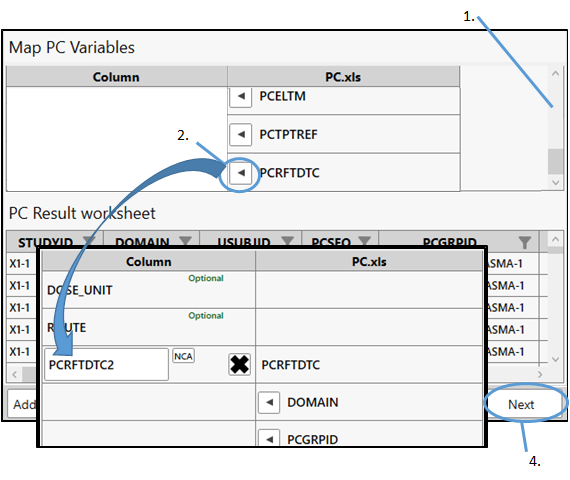
Note:If a variable is manually mapped, PK Submit stores the mapping in a database to allow automatic mapping of the variable the next time it is encountered. The database file is C:\Users\<username>\Documents\Certara\PKSubmit\PK Submit.db.
All required variables are now mapped, so we can proceed to the next step.
During the PC domain creation process, PK Submit checks the data and will warn you of errors that will occur during the validation step. For example, if the USUBJID does not contain the studyID string, which is required for compliant PC domain, you will see a message and be given the option to have the PK Submit concatenate the study ID with the USUBJID to bring it into compliance.
Select NCA keys
-
For this example, we will use the default NCA keys. Click Next.
Merge dosing with concentration information
Dosing and concentration information can be merged by mapping the appropriate variables in the previous step, by entering values directly in the table, or by loading an EX.xpt file. For this example, we will enter our data directly.
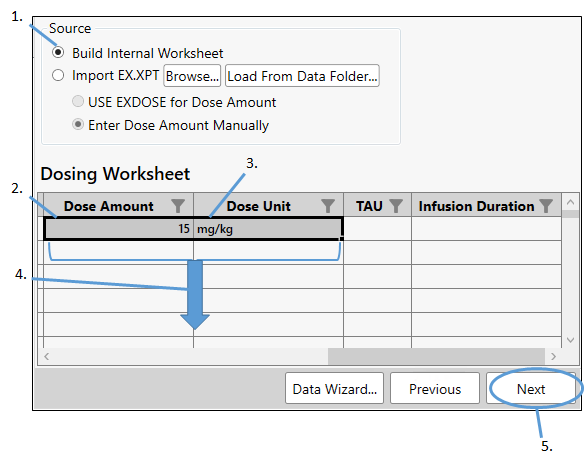
-
Leave the Build Internal Worksheet option selected.
-
Locate the Dose Amount column in the Dosing Worksheet and enter 15 in the first cell.
-
In the Dose Unit column enter mg/kg in the first cell.
-
Select the two cells you entered information into and drag the lower right corner down to copy the values to all cells in the two columns.
-
Click Next.
Exclude data
Set up a filter to exclude data where PCTPT = 0h from the Statistics calculations.
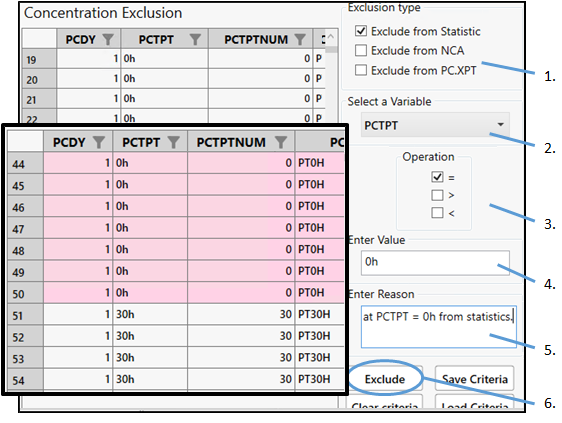
-
Check the Exclude from Statistics box and clear other boxes at the top of the dialog.
-
From the Select a Variable pulldown, scroll down the list and choose PCTPT.
-
Check the box for = under Operation.
-
In the Enter Value field, type 0h.
-
Type the following in the Enter Reason field:
Exclude data at PCTPT = 0h from statistics. -
Click Exclude.
Rows that meet the criteria will be shaded pink to indicate that they are marked for exclusion.
Define a time deviation rule
In this example, we want to identify any data whose sample time deviation is either:
5 minutes or more
Or
98.33% or more of the time deviation
-
Click Time Deviation Rules at the bottom of the page.
-
From the Select Dosing Data Time Column menu, select PCRFTDTC2.
-
In the Rules column, click Add Rule near the bottom.
-
In the newly added row, enter M5M98_33 as the Name.
-
In the Rules column, change the Deviation value to 5.
-
In the Rules column, change the Percentage value to 98.33%.
-
Click OK.
-
Click Next.
In the Data Exclusion table, scroll to the last few columns. The Time Deviation Rule computes values and appends columns for ActualTime, AnalysisEndTime, DeviationPK, PercentDeviation, and DeviationRuleApplied.
Scroll down the rows of data to find the data flagged in the DeviationRuleApplied column.
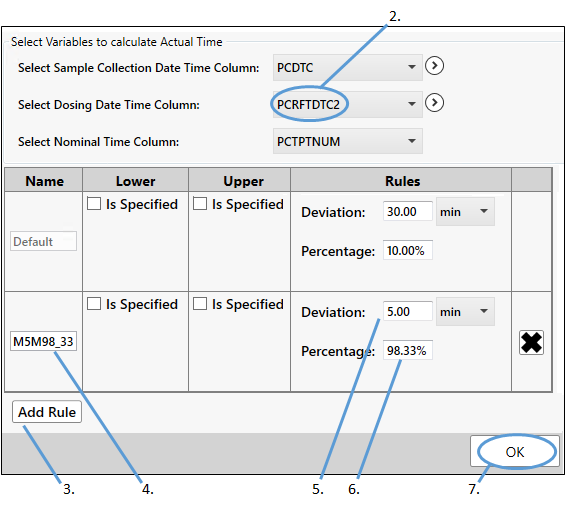
Finish setting up NCA
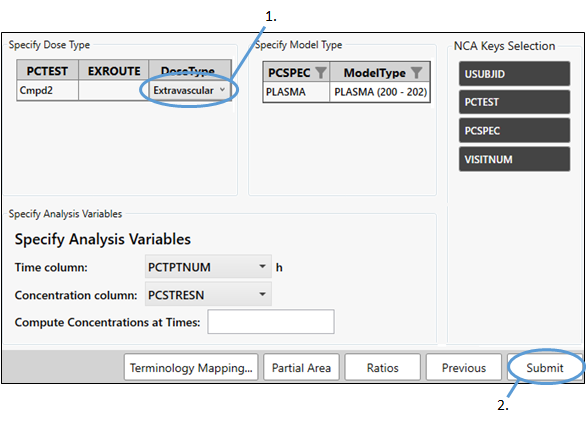
-
Select Extravascular from the Dose Type pulldown.
-
Click Submit.
The PC domain is complete and a Phoenix project is automatically created, with a workflow that has an NCA object preconfigured according to specifications made in PK Submit.
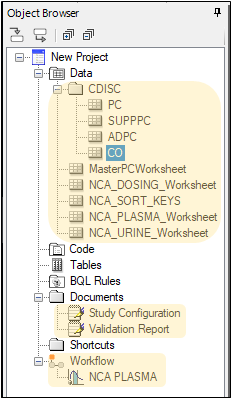
The PP domain can be generated from an NCA, typically the Final Parameters output worksheet. The NCA object set up by PK Submit is ready to execute. Unless you want to review the slope selector, you can simply run the NCA.
Specify the data for the PP domain
-
Rename the project as Example2.
-
Execute the NCA object.
-
Select PK Submit > Create PP Domain from the Phoenix menu.
-
Click OK.
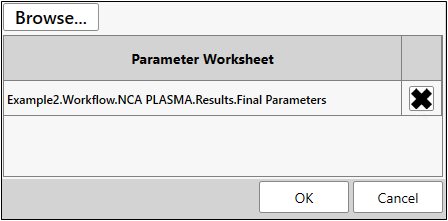
PK Submit will automatically select the Final Parameters result worksheet when there is an open project with an executed NCA object available (such as in this example). Otherwise, use the Browse button.
Select PK parameters
-
For this example, we will keep the default list of Selected PK Parameters and click Next.
Exclude parameters
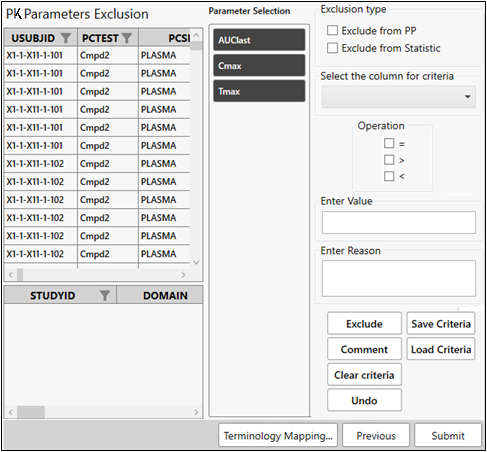
-
In the PK Parameter Exclusion page, click Submit.
The PP domain is created.
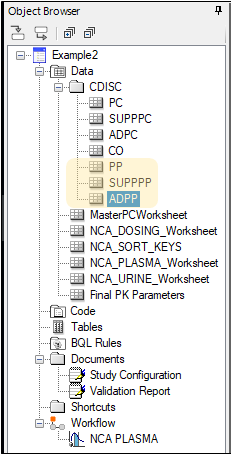
-
Select PK Submit > Create RELREC and POOLDEF Domains from the Phoenix menu.
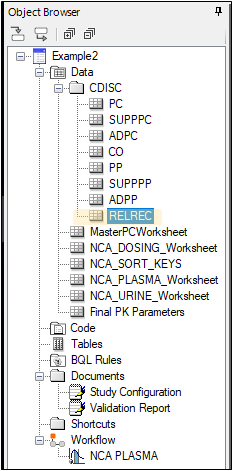
Since this was not a sparse study, no POOLDEF domain is generated.
Create files required for submission
-
Select PK Submit > Create Submission Files from the Phoenix menu.
-
Enter PK Submit Example 2 - X1-1 Study as the Study Name.
-
Enter X1-1 Testing Cmpd2 as the Study Description.
-
Leave the Protocol Name blank.
-
Click OK.
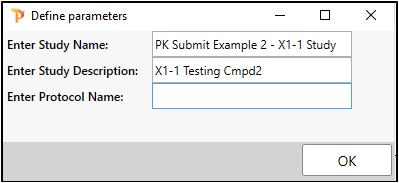
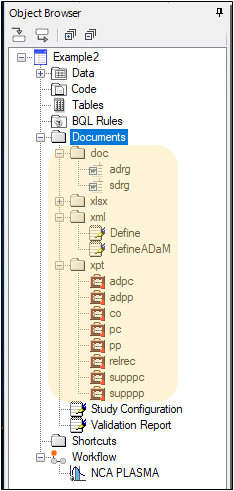
The Study Data Reviewer’s Guide is created and stored in the Documents > docx subfolder of the Object Browser. The template for this document is available on the PhUSE website. PK Submit automatically populates the document with most of the information needed for submission.
The Define.xlsx file is created and stored in the Documents > xlsx subfolder. This Excel-formatted file contains all of the information you find in the Define.xml file for the study in the Documents > xml subfolder.
-
Select PK Submit > Export Submission Files from the Phoenix menu.
-
In the file browser, select the location in which to save the files and click OK.
In the following image, a folder named Example2 was selected.
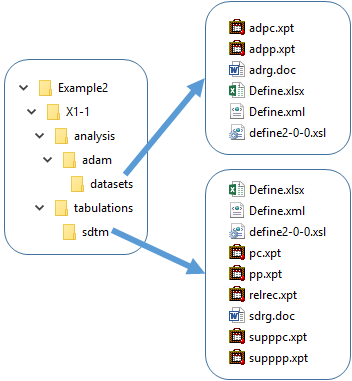
The study information is ready for electronic submission and the process is complete.
